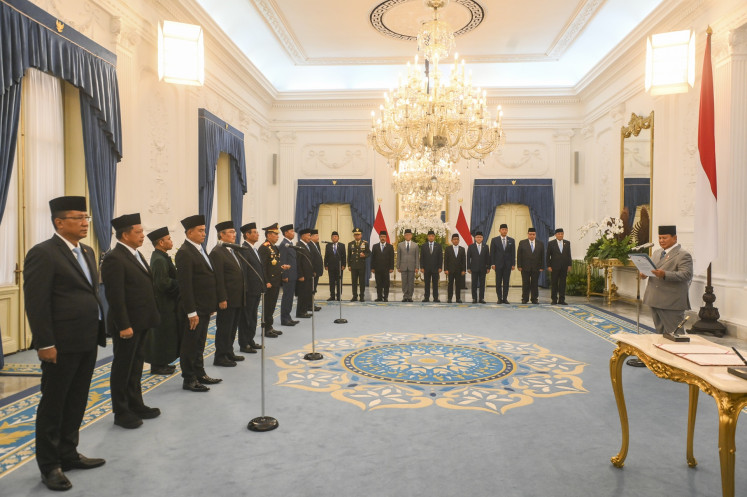Popular Reads
Top Results
Can't find what you're looking for?
View all search resultsPopular Reads
Top Results
Can't find what you're looking for?
View all search resultsA quick visit to Bajra Sandhi monument
It was a rather cloudy Sunday afternoon, but some local and foreign tourists were eager to explore the interior of Bajra Sandhi with their flashing cameras
Change text size
Gift Premium Articles
to Anyone
I
t was a rather cloudy Sunday afternoon, but some local and foreign tourists were eager to explore the interior of Bajra Sandhi with their flashing cameras.
Bajra Sandhi is a monument-cum-museum built in the form of a giant genta - a sacred bell used by Hindu high priests.
The official name of the monument is the Bali People's Struggle Monument, a homage to the Balinese people's independent and fighting spirit exemplified in several historical battles in ancient and recent times.
The 45-meter-tall Bajra Sandhi stands majestically on the southern edge of Puputan Margarana square in Renon, South Denpasar.
The square itself was named after a heroic battle in 1946 in which a troop of 96 Balinese soldiers, led by I Gusti Ngurah Rai, made their last stand against a powerful Dutch contingent in Marga village, Tabanan regency.
In the ensuing battle all the Balinese soldiers perished, and the event came to be known as Puputan in the local Balinese language.
During his tenure in the 1980s, former Bali governor Ida Bagus Mantra came up with the idea to build the monument.
Mantra's single aim was to build a landmark that would enshrine the Balinese people's fighting spirit and nationalism. To this end, a design contest was launched.
An architecture student of Udayana University named Ida Bagus Gede Yadnya won the contest.
The construction of the Bajra Sandhi monument began in 1988, was postponed during the 1997-1999 financial crisis, and was finished in 2001.
The main part of the Bajra Sandhi monument has three floors. The third floor, a vacant and quiet place, gives visitors a magnificent view of the Denpasar skyline.
Visitors, however, must climb an 18-meter-high spiral staircase from the first floor to catch the view.
Also bear in mind that female visitors who are menstruating are forbidden from entering this level.
The first floor houses an information counter and a library as well as exhibition and meeting rooms, a souvenirs shop and toilets. Here, also is a man-made pond filled with Koi carp surrouding the stairs up to the third floor.
The most informative part of Bajra Sandhi is its second floor, with 33 dioramas (made from fibreglass and wood). Displaying scenes from Bali's history, the dioramas have accompanying information in Balinese, Indonesian and English.
The historical display begins with a glimpse of life on earth 3,000 years before Christ. The dioramas also show Bali's early kingdoms era, scenes from Indonesia's battle for Independence and ensuing post-Independence struggles.
Hadi Cahyo Utomo, the monument's information officer, said the dioramas were the most sophisticated part of the site.
"The dioramas are also equipped with audio-based information," he said.
"But unfortunately the audio feature sounded terrible when the recordings of several dioramas were played at once, so we decided to disable it."
The dioramas were created between 2002 and 2003 by some 40 art students of the Indonesian Arts Institute (ISI) of Yogyakarta.
The panoramic paintings on the dioramas' dome-shaped backgrounds were all made by Yogyakarta's painter, the late Ratmoyo.
College students Daphne, Anneloes and Ingrid of the Netherlands said they had fun at the monument that day.
"After seeing these dioramas, I learned more about what we did to you," Anneloes said with a little laugh, refering to the 350-year Dutch colonial period in Indonesia.
Daphne however had a slight criticism of the monument because of its lack of information on the viewing deck.
"On the upper *tower* part, we saw nothing but a city view," she said.
"I guess it could have been more informative if they put up some signs, for example, showing which way Kuta is, and so on."
Information:










